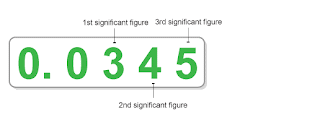Accuracy : how close the measurement comes to the accepted/real value
Precision : how reproducible a measurement is compared to similar measurements
No measurement is exact. Its just a estimation. It may still has some degree of uncertainty
~Absolute uncertainty = largest difference between the average and the lowest/highest measurement
Method 1 : Calculate the average(at least 3)
For example : 8.3, 8.5 & 8.1
Average = 8.3Absolute uncertainty = 8.5 - 8.3 = 0.2
It will recorded as 8.3+/- 0.2
Method 2 : Determine the uncertainty
Measure the best precision that you can. You should estimate to a fraction 0.1 of the smallest segment on the instrument scale.
For example : Thermometer Smallest : 1degree, Best precision : 0.1degree, uncertainty+/- : 0.1degree
~Relative Uncertainty = Absolute uncertainty/Estimated measurement








